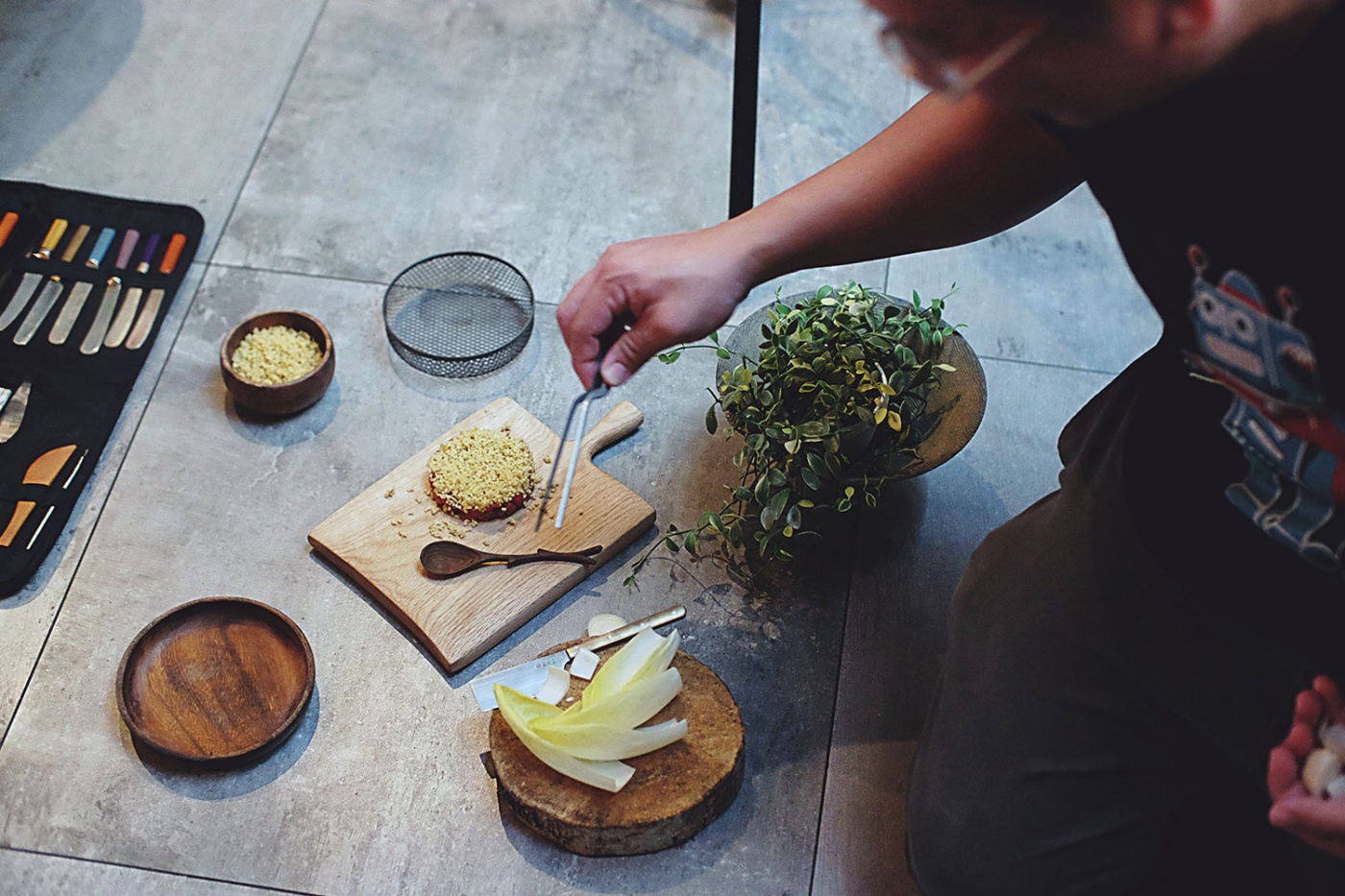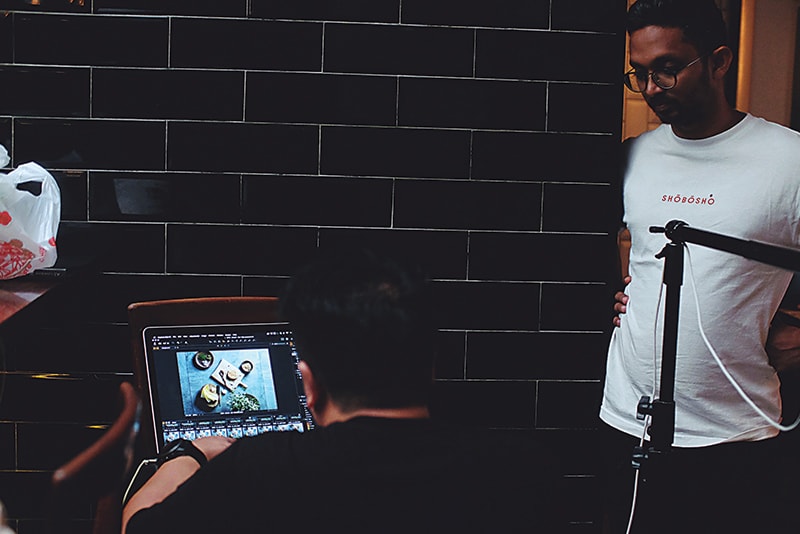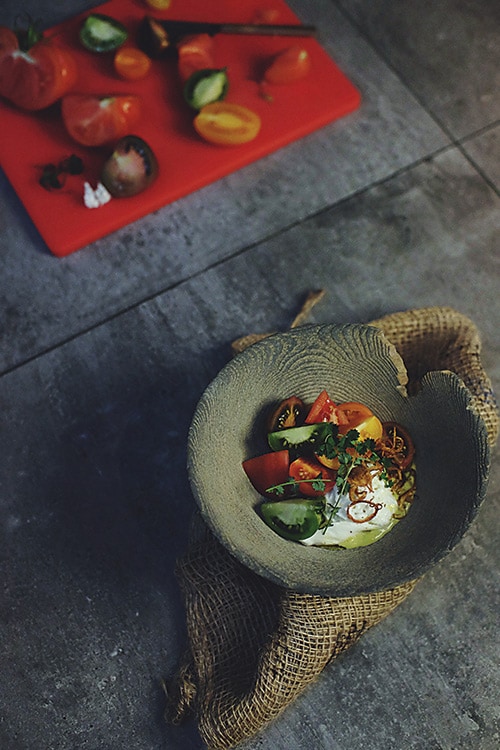Breaking the “Don’t Play with your Food” Rule with Food Photographer John Heng
If you ask John Heng if he had ever considered food photography to be his bread-and-butter trade some 10 years ago—tanned skin, bright-eyed and skin flecked with salt crystals from days spent skimming the seas capturing moments while avoiding perilous crushing situations between fast sailing vehicles in the water—he would have told you that it was a wise choice since inanimate objects were a ‘hell lot less work’. In actual fact, portraying food that is vibrant enough to jump out of pictures and grab the salacious attention of its viewers is a highly niched skill set—almost akin to an artist/foodie/wild child with playful tendencies mashed into one. I accompanied John on one of his photo shoot assignments for Chef Rishi Naleendra’s new bistro, Cheek; and if that is anything to go by, it has taught me one thing—food photography isn’t glamorous and it involves the juggling of various disciplines.
With deft fingers, John starts cutting up herbs and then scatters it gently over the chopping board, positioning it as though a chef had worked on it. It’s a skill I gather that either comes from watching chefs at work or practising the art of cooking in his spare time. A plate of ingenious Pineapple Bak Kwa Pasta graced with a sunshine yolk on his Instagram feed will tell you the latter. “What plates do you want?” he asks Rishi, leading him to reveal a beautiful deep wooden bowl he purchased in Japan. “It’s perfect for the burrata!” Rishi concedes with palpable enthusiasm.
John tells me that not all shoots come with specific directions which are in line with his ‘run with it’ kind of attitude when it comes to photography. In this instance, Cheek by Jowl sheds its outer husk to reveal a more playful personality showcasing sharing plates celebrating bold flavour combinations and unconventional executions. Opening night is just a few hours away and the fact that Rishi is unperturbed about the official photo shoot is a testimony to their seasoned working relationship. “I’m open to opinions but the overall impact should be one that exudes a natural element and a bistro feel,” says Rishi. With the lighting rig set up over the restaurant’s granite floor, John gets to work sprinkling puffed millet around the beef tartare with purposeful intention and chopping endive tips with the cutest cleaver I’ve ever seen. He scours the restaurant walls for anything that can be used as props; pruned money plant and Spanish moss pass muster. He teases its tendrils into place in the lower corner of the frame and the result is a frame that’s assuredly organic.
“Do you want a dug-in look or do you want it presented whole?”John asks. Rishi is too caught up dashing around the kitchen dealing with prep work to keep a close eye on the project. John presses on with resolve. He makes tiny movements on the plate, capturing frames of every small rotation while contemplating including the chopped ends of the endive in the shot. It’s a chaotic style that involves running a trillion ideas simultaneously, but it works. Rishi and Manuela [Toniolo] both give the shot a nod of approval and in less than the stipulated 45 minutes, we move on to the Burrata.
While fussing over the heirloom tomatoes, John muses about his first jaunt with food photography that inspired his later pursuit of food knowledge. It was a similar dish, burrata cheese flanked by heirloom tomatoes that was on the photo shoot agenda. Plated by Chef Sufian Zain, current executive sous chef of Wake Ghin at IGGY’s, an innocent question, “Hey Chef, what exactly are we shooting, ah?” resulted in throngs of information and food facts being disseminated. Much to John’s amusement who later replied nonchalantly, “Oh, so it’s cheese lah! You should have said so earlier.” Chef Sufian’s patience and perseverance reaped rewards and eventually, John’s interest in food was piqued.
“It’s very important to understand the dish and its components prior to shooting it,” he says. “Does it have height and colour? This will affect the choice of your plate as well. How is it presented? If you take away the bones and the wing tip, can people still recognise it as a chicken wing?”
He explains that therefore certain cliched shapes are very important. There is a reason why certain foods are shot a certain way. However, fine dining warrants a certain amount of leeway as people visit those places with the intention to be surprised. At the end of the day, it boils down to whether the branding can adopt that look. Elusive versus approachable. It takes a lot of time and effort in conveying these ideas through images. With so many elements to consider, John tries his best to work within the confinements of the client’s mood boards, however, sometimes he tends to push the envelope at styling, giving a real John Heng touch to his work.
The deliciousness index of the lamb ribs rises significantly thanks to the blow torch brandished across its fatty cross-section. John applies the sticky glaze across the plate like a seasoned painter and places the ribs with geometric precision adjacently. A trickle of infused oil, some chopped up mint and a pile of spices later, the meaty treat is ready to whet your appetite.
“I was a late bloomer. My food photography career didn’t start till I was 28.” A sailing instructor by trade, John’s first engagement was somewhat of a morbid affair. “I didn’t get into photography because I was interested. I had no money to buy cameras and toys back then,” he professes. It was not till he was approached to help out in the Banda Aceh tsunami crisis, namely to bring body bags and medical supplies over on sailboats, did he finally purchase his first camera to document the journey. “This was pivotal to my learning as halfway through the trip, my LCD screen died and I was shooting blind for a month. Albeit, I learnt to meter the hard way.”
Still, sports photography remains his first love. He recounts shooting 20-hour days during the Southeast Asian Games and popping beroccas like it was drugs. “It’s very mentally and physically draining. And after covering a major sports event, you’ll most definitely be suffering from withdrawal effects—shivering in the corner and wondering what you’re doing with your life. The adrenaline derived from these events can be very addictive,” he adds.
Several years down the road, opportunity struck with a freelance photography gig with The Business Times and from there on out, food photography had squirrelled its way into his portfolio.
The last dish to be photographed is goat cheese parfait decked out in shades of pretty pink. John unrolls a paintbrush organiser remodelled to store a dazzling array of forks of different shapes, colours and sizes. “The reason why I bring so many props is to create a sense of excitement for the chefs,” he confesses, “Most of them are jaded, grumpy, underpaid and overworked individuals. So when we reveal our props, it gets them excited about the dish being plated differently and this will encourage them to contribute. As a photographer, you may be good as an individual but sometimes, you have to rely on the chefs to take it further. When two people’s efforts are combined, a higher ground can be reached.”
I pick out a white melamine fork from the mix and he nods at its contemporary theme. Under his direction, I fork the cake, snap, and et voilà!
When I ask John to share a piece of advice for aspiring professional photographers, he says, “Question yourself every step of the way. Do I subtract, add? How do I make it look better? Everyone has their own little quirks, but you should never keep returning back to a fixed formula. Use new equipment, use new modifiers, throw a spanner in the works once in a while and change things up. Only then, can you improve.”





